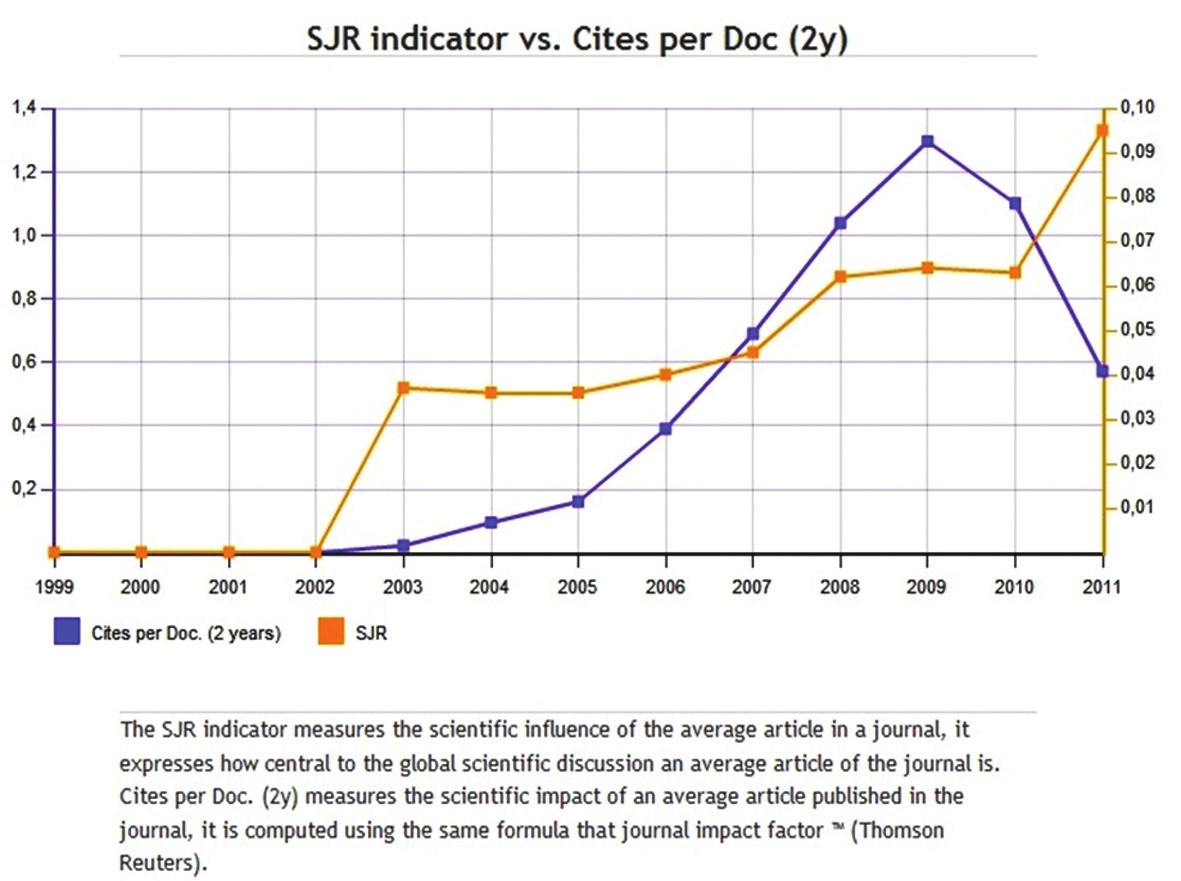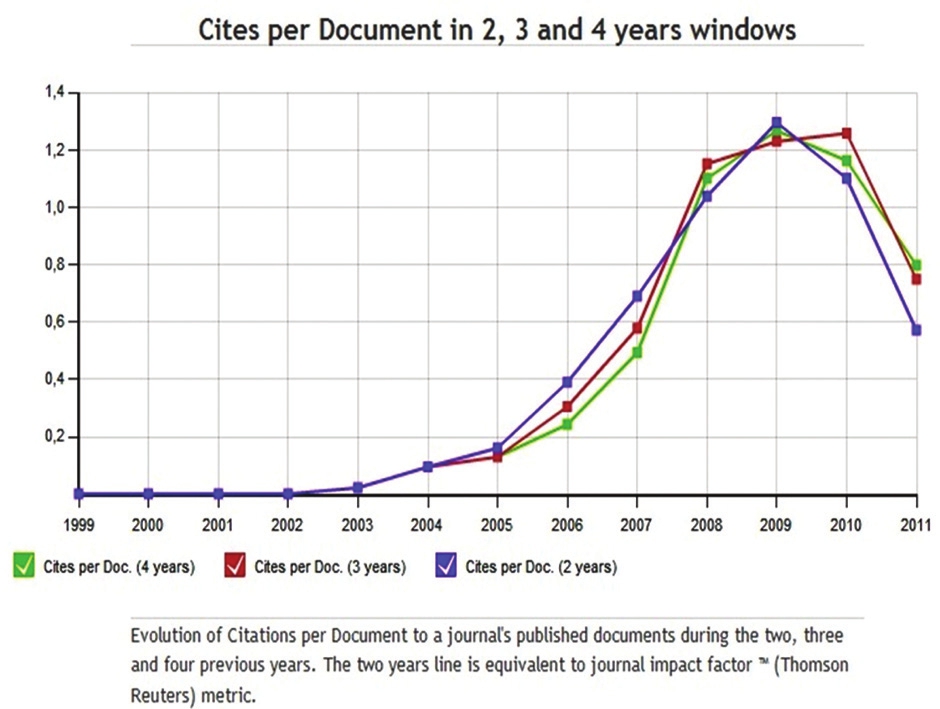Translate this page into:
Performance of Indian Journal of Dermatology, Venereology and Leprology: 2003-2012
Correspondence Address:
Devinder Mohan Thappa
Editor-in-Chief, Indian Journal of Dermatology, Venereology, and Leprology, Professor and Head, Dermatology and STD Department, JIPMER,
India
| How to cite this article: Thappa DM. Performance of Indian Journal of Dermatology, Venereology and Leprology: 2003-2012. Indian J Dermatol Venereol Leprol 2013;79:1-2 |
The Indian Journal of Dermatology, Venereology and Leprology (IJDVL) became an online journal in the year 2003 under the guidance of Dr. Uday Khopkar, former editor in chief. There has been a marked increase in its visibility and citation rates in the last nine years. It has been indexed with a number of indexing agencies, most importantly, the Science Citation Index, MEDLINE, PubMed, SCOPUS, SC Imago Journal Ranking (SJR), and recently, in 2012, it has come on the platform of OVID, a Wolters Kluwer sister concern. The journal got indexed in PubMed and MEDLINE in December 2005, and in June 2010, it received its first Impact Factor (IF) of 0.976. Currently, its Impact Factor (for the year 2011) is 0.979, but it is still short of the elusive figure of 1.0. At present, its H Index is 15.
The online article submission rate has been progressively increasing. In 2008, the number of articles submitted to IJDVL was 579 and the figure rose over one and a half times to 934 in 2011. The distinguishing feature of this online submission was the increased rate of overseas submissions, which rose from 30.5% of all articles in 2008 to 47.2% in 2011. Our rejection rate, however, has also increased correspondingly from 61% in 2008 to 74% in 2011.
The number of articles published in the journal has also been increasing steadily. While 80 articles were published in 2008, the number rose to 231 articles in 2011. This has been possible since more articles were now being published under the e-IJDVL section. Over the years, the journal′s subscriber base has also increased from 172 subscribers in 2008 to 207 in 2011.
The SC Imago Journal Ranking (SJR) indicator measures the scientific influence of the average article in a journal. It expresses how central an average article of the journal is to global scientific discussion. It is represented by the orange coloured line in the graph, showing the impact of the journal in the global arena [Figure - 1]. Cites per document (2 years) measures the scientific impact of an average article published in the journal, and it is computed using the same formula as the Journal Impact Factor. This is represented by the dark blue line in the graph in [Figure - 1], showing a remarkable performance of the journal over the years, especially of late. [Figure - 2] shows cites per document over 2, 3 and 4 years. The 2 years line is equivalent to the Journal Impact Factor.
 |
| Figure 1: A graph showing SJR indicator vs cites per document (2 years) |
 |
| Figure 2: A graph showing cites per document for 2, 3 and 4 years |
From December 2011, the publishing of the journal has been taken over by Wolters Kluwer Health, a global information services and publishing company (Lippincott, Williams and Wilkins). It has under its umbrella, OVID, a global information solutions provider that helps researchers, librarians, clinicians and other healthcare professionals find important medical information, so that they can make critical decisions to improve patient care, enhance on-going research and fuel new discoveries. With IJDVL joining this bandwagon, its impact in the scientific world will increase tremendously.
The journal has to evolve with time. As a new strategy to improve its visibility and generate revenue, it has been decided to make IJDVL available on the iPAD platform from the January-February 2013 issue. A time will surely come, when all new as well as old members will prefer to have it on their iPAD only and the possibility of getting the journal in print format will be by subscription only!
Finally, my thanks are due to all our sponsors for the 2012 print version, especially Gracewell, Galderma India Pvt. Ltd., Glaxo SmithKline (GSK), Dr. Reddy′s laboratories Ltd., INVIDA, Ajanta Pharma, Palsons Derma, and Zydus Liva Health Care Pvt. Ltd., for their financial backing of this scientific activity. Special thanks are due to Systopic Labs Pvt. Ltd. for sponsoring mailing of IJDVL to our members and Galderma India Pvt. Ltd. for sponsoring our website http://www.ijdvl.com.I take this opportunity to congratulate Drs. Ramam, [1] et al. for winning the Bishnupriya Devi Award for best paper published in IJDVL, during the year 2012. I also congratulate Drs. Handa S, Kaur I, Gupta T, Jindal R, authors of the article ′Hand eczema: Correlation of morphologic patterns, atopy, contact sensitization and disease severity′ (Indian J Dermatol Venereol Leprol 2012;78:153-8) for winning the Indubala Memorial Award for best paper published in IJDVL in 2012 on the subject of occupational/contact dermatitis.
From the year 2011, IJDVL has introduced three more prizes for the best case report, best letter to the editor, and best images in clinical practice, for Indian authors only. So, this year′s award for the best case report (in the year 2012) goes to the article ′Primary extramammary Paget′s disease with extensive skeletal metastases′ by Drs. Reddy IS, Swain M, Gowrishankar S, Murthy DN (Indian J Dermatol Venereol Leprol 2012;78:89-92); the award for the best letter to the editor goes to Drs. Kathuria S, Khunger N, Ramesh V for their letter titled ′Clinical and hormonal evaluation in facial pigmentary demarcation lines: A pilot study′ (Indian J Dermatol Venereol Leprol 2012;78:742-4), and for best images in clinical practice to Drs.Ghosh SK, Dutta A, Basu M for their ′Raccoon eyes in a case of metastatic neuroblastoma′ (Indian J Dermatol Venereol Leprol 2012;78:740-1). They get a certificate with cash awards from IJDVL for  5000/-,
5000/-,  3000/-, and
3000/-, and  2000/-, respectively, as incentive to publish their best research work in our journal. Last but not the least, I thank all the contributors for their unstinted support during the year, which is pivotal to the continued success and visibility of our journal.
2000/-, respectively, as incentive to publish their best research work in our journal. Last but not the least, I thank all the contributors for their unstinted support during the year, which is pivotal to the continued success and visibility of our journal.
I take this opportunity to wish all of you a very happy, healthy and prosperous new year!
| 1. |
Ramam M, Kumar U, Bhat R, Sharma VK. Oral drug provocation test to generate a list of safe drugs: Experience with 100 patients. Indian J Dermatol Venereol Leprol 2012;78:595-8
[Google Scholar]
|
Fulltext Views
2,753
PDF downloads
1,019





